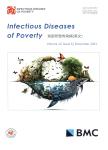Effect of temperature on the Bulinus globosus-Schistosoma haematobium system
Effect of temperature on the Bulinus globosus — Schistosoma haematobium system作者机构:School of Nursing and Public HealthCollege of Health SciencesHoward College CampusUniversity of KwaZulu-NatalDurbanSouth Africa School of Life SciencesCollege of AgricultureEngineering and ScienceWestville CampusUniversity of KwaZulu-NatalDurbanSouth Africa
出 版 物:《Infectious Diseases of Poverty》 (贫困所致传染病(英文))
年 卷 期:2017年第6卷第1期
页 面:495-501页
核心收录:
学科分类:1002[医学-临床医学] 100214[医学-肿瘤学] 10[医学]
基 金:The study received financial support from University of KwaZulu-Natal College of Health Sciences through the student scholarship programme,and from United Nations International Children's Fund/United Nations Development Programme/World Bank/World Health Organization Special Programme for Research and Training in Tropical Diseases from the Canadian International Development Research Centre through their support towards a Malaria and Bilharzia in Southern Africa project
主 题:Bulinus globosus Cercariae Development rate Fecundity Schistosomiasis Schistosoma haematobium Temperature
摘 要:Background:Given that increase in temperature may alter host-parasite relationships,the anticipated rise in temperature due to global warming might change transmission patterns of certain ***,the extent to which this will happen is not well ***:Using a host-parasite system involving Bulinus globosus and Schistosoma haematobium,we assessed the effect of temperature on snail fecundity,growth,survival and parasite development under laboratory ***:Our results show that temperature may have a non-linear effect on snail fecundity and snail *** maintained at 15.5℃ and 36.0℃ did not produce egg masses while those maintained at 25.8℃ laid 344 and 105 more egg masses than snails at 31.0℃ and 21.2℃,*** of patency led to a reduction in egg mass production among the ***,the reduction in fecundity for snails maintained at 21.2℃ occurred before snails started shedding *** development was accelerated at high temperatures with snails maintained at 31.0℃ reaching patency after three ***,snail growth rate was highest at 25.8℃ while it was inhibited at 15.5℃ and reduced at 31.0℃.Increase in temperature increased snail mortality *** maintained at 36.0℃ had the shortest survival time while those maintained at 15.5℃ had the longest survival ***:We concluded that temperature influences fecunxdity,growth,survival and parasite development in the snail and thus dictates the time it takes the parasite to complete the life *** has implications on transmission of schistosomiasis in the context of global warming.



